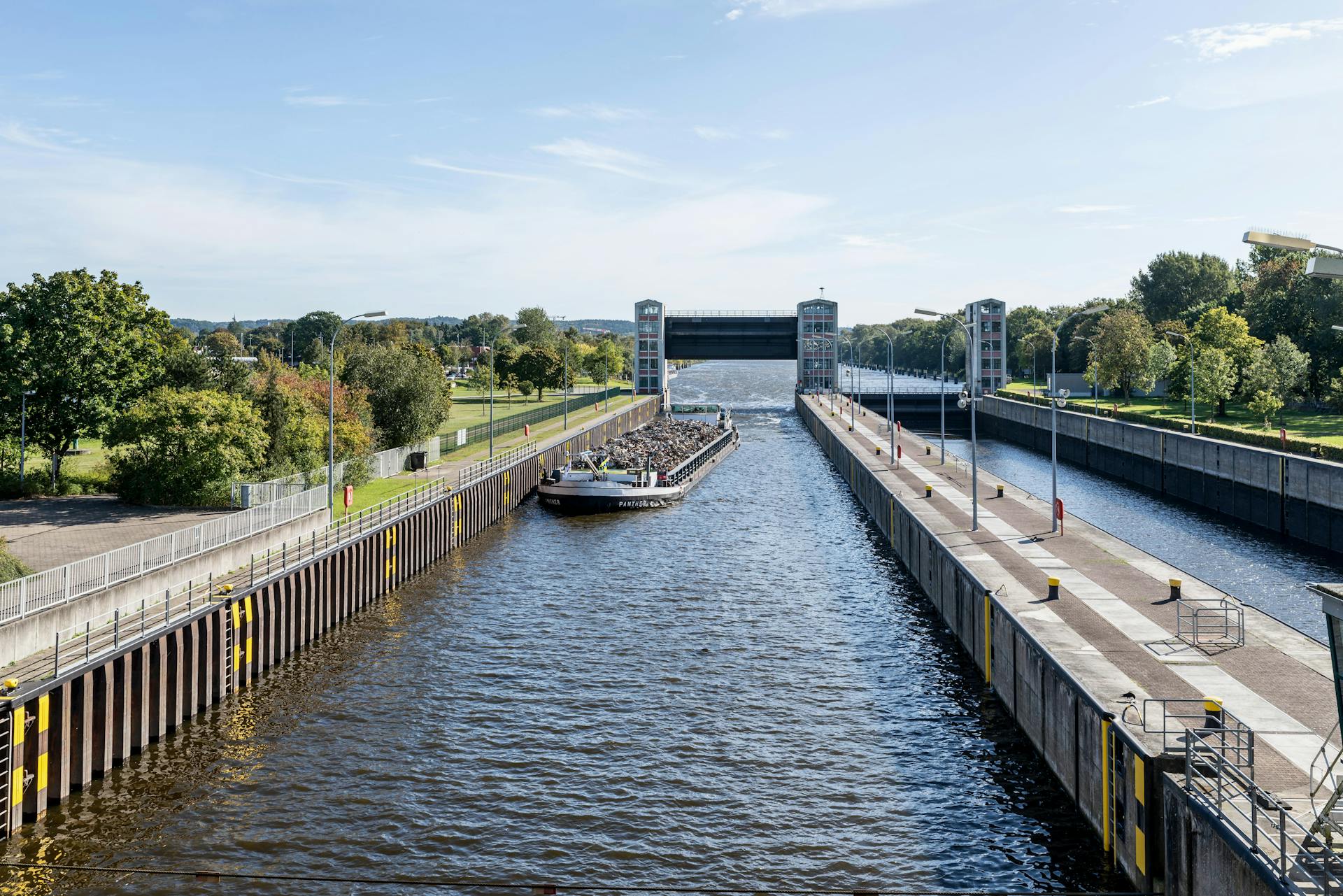
Pound locks are a crucial component in water navigation and engineering, allowing boats to pass through canals and rivers with varying water levels.
They work by creating a controlled environment for boats to enter and exit the waterway, with gates at either end that can be opened and closed to adjust the water level.
This process is made possible by the use of gates, which are typically made of steel or concrete and can be lifted or lowered to control the water flow.
Pound locks are essential for maintaining a consistent water level, which is vital for safe navigation and preventing erosion.
Pound Lock Basics
A pound lock is most commonly used on canals and rivers today, and it's a pretty straightforward technology.
The basic construction of a pound lock consists of a watertight chamber connecting the upper and lower canals, and large enough to enclose one or more boats. The position of the chamber is fixed, but its water level can vary.
A gate, often a pair of "pointing" half-gates, is located at each end of the chamber. A gate is opened to allow a boat to enter or leave the chamber; when closed, the gate is watertight.
The lock gear to empty or fill the chamber usually includes a simple valve, traditionally a flat panel (paddle) lifted by manually winding a rack and pinion mechanism.
To operate a pound lock, the entrance gates are opened and the boat moves in, then the entrance gates are closed and a valve is opened to lower the boat by draining water from the chamber.
Here's a step-by-step breakdown of the process:
The whole operation will usually take between 10 and 20 minutes, depending on the size of the lock and whether the water in the lock was originally set at the boat's level.
Lock Components
A lock's components are surprisingly simple, yet effective. The paddle is connected to a metal rod, which in turn is connected to a metal-toothed bar or rack.
The rack, and the paddle, is pulled up or down by the pinion, a round, toothed gear that meshes with the teeth on the rack. The pinion is turned by a windlass crank, also called a lock key, which is inserted over a spindle or shaft.
These components work together to control the flow of water into and out of the lock, making it possible to raise or lower boats between different levels of the canal.
Gates
Gates are the watertight doors that seal off the chamber from the upper and lower pounds. Traditionally, they were made of oak or elm, but now they're usually made of steel.
The most common arrangement, called miter gates, was invented by Leonardo da Vinci in the late 15th century. This type of gate is still widely used today.
Gates are usually made up of two half-gates, one at each end of the chamber. They're designed to be watertight, so water can't leak in or out of the chamber.
The gates are typically controlled by paddles, which are connected to a metal rod and a metal-toothed bar or rack. This mechanism allows the gates to be opened and closed smoothly.
In some cases, the gates are operated by a windlass, which is a crank that turns a pinion to raise or lower the gates. This is a common way to operate gates on canals.
Sump
A sump pound is a point where every boat entering or leaving the pound causes an addition of water. This is the opposite of a summit pound, where water is actually lost.
The longest sump pound is the 11.6-mile Fenny Stratford pound on the Grand Union Canal, between Cosgrove Lock and Fenny Stratford lock. This sump pound needs a way to discharge the surplus water, which is done by a large viaduct and aqueduct that carries the canal over the River Great Ouse.
In a sump pound, water is added to the system, whereas in a summit pound, water is lost. This is an important distinction to understand when navigating canals with these types of locks.
Lock Types
There are several types of locks that can be used in a pound lock system, including mechanical locks and hydraulic locks. Mechanical locks use a combination of levers and pins to secure the lock, while hydraulic locks use water pressure to open and close the lock.
The most common type of mechanical lock used in a pound lock system is the lock gate, which is a type of lock that allows boats to pass through while keeping the water level in the pound stable. Lock gates are typically made of metal and are designed to be durable and long-lasting.
In a hydraulic lock system, the lock is opened and closed by adjusting the water level in the pound, which is controlled by a series of gates and valves.
Composite Locks
Composite locks were made to economize on good stone, which was often expensive or difficult to obtain.
These locks were constructed using rubble or inferior stone, which was then dressed with wood to prevent abrasion on the boats.
The Chesapeake and Ohio Canal featured composite locks near the Paw Paw Tunnel, and the Chenango Canal also used this type of lock.
Paired Locks

Paired locks are designed to be used in conjunction with a key, but they require two keys to operate. This type of lock is often used in high-security applications.
One key is used to lift the bolt, while the other key is used to turn the lock's mechanism. This makes it extremely difficult for an unauthorized person to gain access.
Paired locks are typically found on high-end safes, vaults, and other secure storage containers. They're also used in some industrial settings where sensitive equipment needs to be protected.
Each key is carefully crafted to fit a specific lock, making it virtually impossible to pick the lock or use a duplicate key. This level of security is ideal for protecting valuable assets.
Round Locks
Round locks are a unique type of lock that can be found in certain canals and waterways. The Agde Round Lock on the Canal du Midi in France is a notable example, serving as a lock on the main line of the canal and allowing access to the Hérault River.
The Agde Round Lock is not the only round lock in France. A second example, the Écluse des Lorraines, connected the Canal latéral à la Loire with the River Allier, although it's now disused.
These round locks are a testament to the ingenuity of canal engineers, who designed them to navigate the specific waterways and geography of their time.
Stop Locks
Stop locks were used in situations where water levels couldn't be guaranteed, such as when the new canal was low.
A stop lock would be built under its own control, with gates pointing towards its own canal, to prevent water from flowing into the adjacent canal. This resulted in a sequential pair of locks with gates pointing in opposite directions.
One example of a stop lock was at Hall Green near Kidsgrove, where the southern terminus of the Macclesfield Canal joined the Hall Green Branch of the earlier Trent and Mersey Canal. This stop lock was a four gate stop lock.
The four gate stop lock near Kings Norton Junction was replaced in 1914 by a pair of guillotine lock gates.
Lock Mechanism and Operation
A pound lock's mechanism is surprisingly simple. The lock has three main elements: a watertight chamber, gates at each end, and a set of lock gear to empty or fill the chamber.
The lock gear is usually a simple valve that allows water to drain into or out of the chamber. Larger locks may use pumps. The valve is traditionally operated by manually winding a rack and pinion mechanism, which is turned by a windlass crank.
The operation of a pound lock is straightforward. For a boat going upstream, the process involves entering the lock, closing the lower gates, filling the lock with water from upstream, opening the upper gates, and exiting the lock. For a boat going downstream, the process is reversed.
Here's a step-by-step breakdown of the lock's operation:
The entire operation typically takes between 10 and 20 minutes, depending on the size of the lock and whether the water in the lock was originally set at the boat's level.
Windlass
A windlass is a crucial component in the lock mechanism, particularly in older canal systems like the Chesapeake and Ohio Canal. It's essentially a device that helps to operate the lock paddles.
The lockkeepers on the Chesapeake and Ohio Canal were required to remove the windlasses from all lock paddles at night, to prevent unauthorized use.
Drop Locks
Drop locks are a type of lock that can be found on canals, particularly in Scotland. They consist of a single long chamber that incorporates a sump.
The only example of a drop lock that has been constructed is at Dalmuir on the Forth and Clyde Canal in Scotland. It was incorporated during the restoration of the canal.
In this type of lock, water can be drained to a nearby burn when water supplies are adequate, rather than using electricity to pump the water back up to the canal. This is a more environmentally friendly option.
A bypass culvert is needed to allow water to move along the interrupted pound and supply locks further down the canal.
Lock Mechanism
A pound lock typically has three essential elements: a watertight chamber, a gate at each end, and a set of lock gear to empty or fill the chamber.
The watertight chamber connects the upper and lower canals and is large enough to enclose one or more boats. The chamber's water level can vary.
A gate, often a pair of "pointing" half-gates, is at each end of the chamber. A gate is opened to allow a boat to enter or leave the chamber; when closed, the gate is watertight.
The lock gear typically consists of a simple valve, traditionally a flat panel (paddle) lifted by manually winding a rack and pinion mechanism. Larger locks may use pumps.
The valve is used to empty or fill the chamber as required. This is usually a simple process involving the opening or closing of the valve to allow water to drain into or out of the chamber.
The operation of a pound lock involves a series of steps, including:
- Opening the entrance gates and allowing the boat to move in
- Closing the entrance gates
- Opening the valve to lower the boat by draining water from the chamber
- Opening the exit gates and allowing the boat to move out
The time it takes to operate a lock can vary, but it usually takes between 10 and 20 minutes, depending on the size of the lock and whether the water in the lock was originally set at the boat's level.
Lock Mechanism and Operation
A pound lock is the most common type of lock used on canals and rivers today. It has a chamber with gates at both ends that control the level of water in the pound.
The basic construction and operation of a pound lock is straightforward. For a boat going upstream, the process involves entering the lock, closing the lower gates, filling the lock with water from upstream, opening the upper gates, and exiting the lock. For a boat going downstream, the process is reversed: entering the lock, closing the upper gates, emptying the lock by draining its water downstream, opening the lower gates, and exiting the lock.
All pound locks have three essential elements: a watertight chamber, gates at each end, and a set of lock gear to empty or fill the chamber as required. The entrance gates are opened, the boat moves in, the entrance gates are closed, a valve is opened to lower the boat by draining water from the chamber, and the exit gates are opened and the boat moves out.
The whole operation of a pound lock typically takes between 10 and 20 minutes, depending on the size of the lock and whether the water in the lock was originally set at the boat's level. Boaters approaching a lock are often pleased to meet another boat coming towards them, as this boat will have just exited the lock on their level and saved them about 5 to 10 minutes.
Here's a step-by-step guide to operating a pound lock:
- The entrance gates are opened and the boat moves in.
- The entrance gates are closed.
- A valve is opened, lowering the boat by draining water from the chamber.
- The exit gates are opened and the boat moves out.
Keep in mind that the process is reversed for a boat going upstream.
Hydro-Pneumatic Canal Lift
Hydro-pneumatic canal lifts use compressed air to raise and lower locks, as seen in the "hydro-pneumatic double balance lock" patented by William Congreve in 1813. This design was attempted by the Regents Canal Company in 1817 at Camden Lock, north London.
The motivation behind this design was to address water supply problems, specifically the need to raise the water level to feed the canal. Congreve's design was modified by the company, but it proved to be unsatisfactory and was soon replaced by conventional locks.
The concept of a hydro-pneumatic canal lift is similar to a caisson lock, where a chamber, or caisson, rises and falls to allow boats to navigate through rivers and canals with varying water levels.
Locks in Navigation
Pound locks are commonly used on canals and rivers today. They have a chamber with gates at both ends that control the water level.
A pound lock can raise the water level by 138 feet in the Grand Canal. This is achieved by allowing water to accumulate in the chamber until the required level is reached.
In medieval Europe, a pound lock was built in 1373 at Vreeswijk, Netherlands, which serviced many ships at once in a large basin. The first true pound lock was built in 1396 at Damme near Bruges, Belgium.
Boat captains need to navigate their boats through locks to adjust to different water levels. Locks allow boats to pass through rivers and canals with varying water levels.
River Navigation
River navigation is a complex process that requires careful planning and execution. Locks play a crucial role in this process by allowing boats to pass through rivers with varying water levels.
Boat captains need to navigate their vessels from one stretch of water to another, often through rivers and canals with different water levels. Locks function as cavities that enable the water levels to vary, making navigation easier.
Locks can be required in a stretch of river to overcome obstacles like mill weirs, dams, or rapids. Weirs and locks are used together in larger scale river navigational enhancements.
By building a sea lock into the estuary, a river can be made non-tidal. Locks are required in advanced river navigations.
Flood locks protect the upstream end of the cut in the case of a longer cut circumvention around the stretch or river.
Fish Ladders
Fish ladders are designed to help fish navigate around locks and other river obstructions.
Fish such as lampreys and trout need to swim upstream to spawn, but locks can block their path.
Measures like fish ladders help counteract this problem.
Some locks can even be operated as fishways, providing access for a range of biota.
Navigation locks have the potential to be a boon for fish populations, not just human travelers.
History and Development
Pound locks have a rich history that dates back thousands of years. They originated as a natural extension of the flash lock, also known as a staunch.
The first recorded use of pound locks was in Imperial China and ancient Europe, where Greek engineers used them in the Canal of the Pharaohs under Ptolemy II (284 to 246 BC).
Pound locks were also used in medieval China during the Song dynasty (960–1279 CE). Qiao Weiyue, a high-ranking tax administrator, installed a pair of sluice-gates two hundred and fifty feet apart in 984, creating a short stretch of canal that effectively acted as a pound-lock.
This innovative design allowed for a more efficient and safer transportation of goods, especially grain barges, which were prone to being wrecked on the West River near Huai'an in Jiangsu.
The intervening level between locks in a pound lock system remains largely constant, unlike the variable levels created by flash locks. This design feature made pound locks a more reliable and practical solution for canal navigation.
Lock Terminology and Details
A pound is the level stretch of water between two locks (also known as a reach). This stretch of water is crucial for navigation, as it allows boats to travel smoothly and efficiently.
Locks are essentially gates that control the water level between the pound and the next section of canal or waterway. They're designed to facilitate the passage of boats from one level to another.
The level stretch of water, or pound, is what makes navigation possible in a canal system. Without it, boats would struggle to move through the waterway.
In a pound lock, the water level is controlled by gates that open and close to allow boats to pass through. This process is repeated at each lock, gradually raising or lowering the boat to the desired level.
Featured Images: pexels.com


